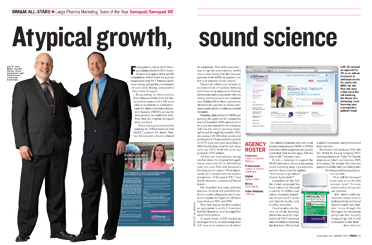AllStarsLargePharma.pdfFacing patent expiry for its Seroquel antipsychotic in 2012, AstraZeneca won approval for an XR formulation, which won’t see generic competition until 2017. Patients on the time-release pill get the convenience of once-daily dosing, compared to twice-daily Seroquel.
Responding to observations from clinicians in the field, AZ also secured an approval for XR as an add-on treatment to antidepressants for adults with major depressive disorder (MDD), giving the new product an additional attribute that the original Seroquel does not have.
“There was a good rationale for studying the XR formulation with MDD,” explains Dr. Jamie Mullen, AZ executive director, clinical development. “Part of the rationale…was to up the convenience [with] once-a-day dosing but also because patients with MDD, in general, are not very tolerant of side effects.”
These side effects can include an increased risk of suicidal thinking and behavior in depressed children, adolescents and young adults who are taking antidepressants, the company says. Adding XR to their regimen was shown to be superior to taking antidepressants alone in reducing suicidal thoughts.
Running clinical trials in MDD, and gaining the approval for adjunctive use in December 2009, turned out to be a wise investment for the company. XR was the fastest growing atypical brand through September 2010, increasing 1.26 TRx share points and posting total US prescription growth of 115% year over year, according to IMS Health data cited by AZ. Sales were up 105% from the year-ago period to $754 million.
AZ has also maintained a strong market share for original Seroquel, whose sales rose 6% to $4.3 billion year over year. Still, with Seroquel’s looming patent expiry: “Most importantly, we’re pleased with the market acceptance of Seroquel XR,” says Sandy Sommer, commercial brand leader.
The franchise had some setbacks last year. In April, AZ paid $520 million to resolve allegations that it marketed regular Seroquel for off-label uses, between 2001 and 2006.
Then, last August, the firm reached an agreement to settle US product liability litigation over Seroquel for about $198 million.
A major focus of XR marketing messages now is on addressing what AZ sees of an unmet need: about “two-thirds of patients who start on an initial antidepressant (SSRI or SNRI) don’t have their symptoms adequately controlled. That was the space XR was able to fill,” Sommer says.
To wit: a campaign to support the MDD indication shows a menacing cloud hovering near a prospective patient’s head with the tagline: “Still trying to get ahead of your depression?”
Launched in the fall, the cloud campaign has been rolled out through a variety of offline and online channels including broadcast TV, print and digital media, and in-office materials.
Cloud creative also figures on all the detailing platforms used by reps and in all HCP-oriented sales brochures, marking the first time XR has had a unified consumer and professional look and feel.
Previously AZ marketed XR with the MM&M Award-winning DTC campaign known as “Fade,” for bipolar depression, which ran from late 2009, leveraging the insight that bipolar patients feel like they are fading into the background during depressive periods.
How will the Seroquel team seek to evolve the science next? No new registration programs are planned.
But “there’s still considerable unmet need in both psychotic and mood disorders and,” says Mullen, “even though the Seroquel development program has largely wrapped up, AZ is still committed to the field.”
From the January 01, 2011 Issue of MM+M - Medical Marketing and Media







